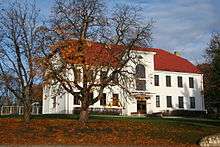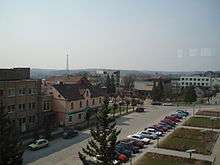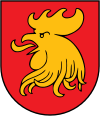Madona
| Madona | |||
|---|---|---|---|
| Town | |||
|
Madona skyline | |||
| |||
 Madona Location in Latvia | |||
| Coordinates: 56°51′N 26°13′E / 56.850°N 26.217°ECoordinates: 56°51′N 26°13′E / 56.850°N 26.217°E | |||
| Country |
| ||
| District | Madona municipality | ||
| Town rights | 1926 | ||
| Government | |||
| • Mayor | Andrejs Ceļapīters | ||
| Area | |||
| • Total | 10.5 km2 (4.1 sq mi) | ||
| Population | |||
| • Total | 9,394 | ||
| • Density | 895/km2 (2,320/sq mi) | ||
| Time zone | EET (UTC+2) | ||
| • Summer (DST) | EEST (UTC+3) | ||
| Postal code | LV-4801 | ||
| Calling code | +371 648 | ||
| Number of city council members | 11 | ||
Madona (![]() pronunciation ; German: Madohn) is a town with town rights in the Vidzeme region of Latvia and is the center of the Madona municipality.
pronunciation ; German: Madohn) is a town with town rights in the Vidzeme region of Latvia and is the center of the Madona municipality.


History
The surrounding area of Madona had been populated in earlier times, which is confirmed by discoveries of old burial grounds in the city's vicinity. Madona is first mentioned in writing in 1461, when Archbishop Sylvester began renting the lands of Birži Manor. However, the Swedish government placed the land under state control. After the Great Northern War, Madona became property of the Russian Empire. Empress Elizabeth presented Birži Manor along with other of Vidzeme's manors to Count Alexander Buturlin.
Empress Catherine II bought the lands back as a present to another relative of her court — the Serbian major-general Maxim Zorić. From the 19th to the beginning of the 20th century, the location of Madona was the fields of Birži Manor.
According to one version, the name of Madona stems from the adjacent Madona Lake. According to another version, Madona got its name from Birži Manor, which German exonym is Madohn or Modohn. For this reason, the railway station situated at the Pļaviņas - Valka narrow gauge railway line was named Madona as well. The populated place that slowly emerged around the station also got this name after the erection of the Madona railway station in 1903.[1]
Village privileges was given to Madona 1 July 1921, and town privileges 7 June 1926. Since 1 April 1925 Madona was the center of the newly founded Madona parish. Madona had 1,357 inhabitants at the time.
Population
The Latvian Central Statistics Department reported 9,242 citizens as of 1 January 2007, with 888 people per square kilometre (0.37 square miles).
When it comes to age distribution of the Madona inhabitants, the majority group consisting of 50,925 people are registered as "labour-capable" (Latvian: darbaspējīgie); 1,339 are under the age of "labour-capability" and 1867 are over. As of 21 December 2003, there are 211 (3.5%) unemployed citizens of the labour force.[2]
Geography
The town of Madona lies in hilly surroundings, that descents underneath the town in a northwestern-southeastern direction. Several minor rivers and streams flows through the town, such as: Lisa River, Leivārīte, Ridzīte, Mucenieki River, Rieba River and Madona River — which flows can be seen in beautiful glens, like: The Love Glen, The Wedding Glen and The Divorce Glen. In The Love Glen is a park, in which the manmade water reservoir has one of the highest fountains in Latvia.
Notable locations and objects
- Madona City Museum — founded in 1944, the museum owns more than 107,000 historical items, it is located in historical Birži Manor.
- The Love Glen (Latvian: Mīlestības grava). Through The Love Glen flows the Madona River, along which shores slings park footpaths. At the entrance a pond with a fountain can be found.
- Madona Second High School — first three-storey building in Madona, built 1924–26.
- Former hotel building — among the oldest buildings in town, built 1901 of boulders and bricks.
- Lazdona Lutheran Church — built 1802–05, inaugurated 1806.
- Lazdona Holy Trinity Orthodox Church — built 1863–66.
- Madona Catholic Church — built 1931–34.
Tourism
Madona is 170 km from Latvian capital Riga, eastern direction. Most popular tourism objects in Madona and surrounding:
- Hill Gaizinkalns. Gaizinkalns is the highest point of Latvia. It is 311.6 m above sea level. Visitors can take a walk for the 2 km long walking trail with beautiful views. Hill surrounding has evolved winter sports offer - comfortable skiing centers and accommodation.
- Teici and Krustkalni nature reserves. The aim of these reserves is to provide ecosystems protection and natural development. There is an opportunity for tourists with a guide to see these protected nature territories, use birds watchtower. The total area of the reserve is 19 657 ha.
- Kalsnava arboretum - largest collection of decorative trees and bushes in eastern part of Latvia, with total area 130,37 ha.
- Lubana lake -the part of largest lake in Latvia is in Madona district. Beside the lake is possible fishing, swimming, using bird -watching tower, rent a telescope and bike.
- Interesting farms - for tourists is open 13 farms: Rabbits and goats farm "Sveki", goat farm "Līvi", "Kucuru mill", farm "Ataugas".
- Winter sports and recreation centers: Sport center "Smeceres sils",[3] who is located next to Madona town. There are organized biathlon and cross-country skiing competitions (Scandinavian cup 2013 and World-cup Ski-orienteering competition 2013). Recreation center "Gaizins",[4] Skiing center "Viešūra kalns",[5] recreation complex "Rēķu kalns"[6] -Alpine skiing,snowboarding, cross-country skiing, the tube-slope.
- Madona local history and art museum [7]-more than 20 artistic and thematic exhibition in year.
- Different workshops (arts and crafts)and cultural events (Latvian symphonic music festival 29.07.2013; session of guitarist 24.03.2013; Fire Sculpture festival 21.06.2013; Town festival 07.06.2013.
- Accommodation - 1 SPA hotel "Marcienas Manor",[8] 5 Hotels, 13 Guest houses, 4 Country houses, 11 Holiday cottages, 4 Hostels and 6 Campings.
- Madona Tourism information centre, Saieta square 1, Madona. Phone.+371 64860573;[9]
References
- ↑ Apinis K. Latvijas pilsētu vēsture. Rīgā, 1931, p. 41
- ↑ Interneta resurss, www.madona.lv
- ↑ http://www.smeceressils.lv
- ↑ http://www.gaizins.lv
- ↑ http://www.viesurakalns.lv
- ↑ http://www.rekukalns.lv
- ↑ http://www.madonasmuzejs.lv
- ↑ http://www.marciena.eu
- ↑ http://www.madona.lv
External links
| Wikimedia Commons has media related to Madona. |
| Wikivoyage has a travel guide for Madona. |


